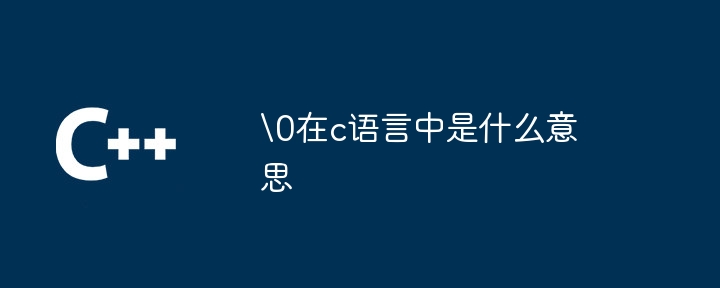What does \0 mean in c language
C 语言中,\0 是字符串的结束标志,称为空字符或终止符。由于字符串在内存中以字节数组形式存储,编译器通过 \0 识别字符串结束,确保正确处理字符串。\0 工作原理:编译器遇到 \0 时停止读取字符,之后的字符被忽略。\0 自身不占存储空间。好处包括可靠的字符串处理、提高效率(无需扫描整个数组查找结束)以及方便比较和操作。
 mean in c language" >
mean in c language" >
C语言中\0的含义
在C语言中,\0是一个特殊字符,表示字符串的结束。它被称为空字符或终止符。
为什么需要\0?
字符串在内存中是以一个字节数组形式存储的。当编译器遇到\0字符时,它就会知道字符串已经结束。这对于编译器正确处理字符串非常重要。
\0的工作原理
- 当编译器在字符串中遇到\0时,它会停止读取字符。
- 因此,\0之后的任何字符都被忽略。
- \0字符本身不占用任何存储空间。
示例
考虑以下字符串:
char str[] = "Hello";
在这个例子中,str数组保存了以下字符:
<code>H | e | l | l | o | \0</code>
\0字符表示字符串的结束,因此编译器知道str数组只包含前5个字符。
使用\0的好处
使用\0的好处包括:
- 允许对字符串进行可靠的处理。
- 提高了程序的效率,因为编译器不必扫描整个字符串数组来查找结束。
- 促进了字符串数组之间的轻松比较和操作。
The above is the detailed content of What does \0 mean in c language. For more information, please follow other related articles on the PHP Chinese website!

Hot AI Tools

Undresser.AI Undress
AI-powered app for creating realistic nude photos

AI Clothes Remover
Online AI tool for removing clothes from photos.

Undress AI Tool
Undress images for free

Clothoff.io
AI clothes remover

AI Hentai Generator
Generate AI Hentai for free.

Hot Article

Hot Tools

Notepad++7.3.1
Easy-to-use and free code editor

SublimeText3 Chinese version
Chinese version, very easy to use

Zend Studio 13.0.1
Powerful PHP integrated development environment

Dreamweaver CS6
Visual web development tools

SublimeText3 Mac version
God-level code editing software (SublimeText3)

Hot Topics
 Usage of typedef struct in c language
May 09, 2024 am 10:15 AM
Usage of typedef struct in c language
May 09, 2024 am 10:15 AM
typedef struct is used in C language to create structure type aliases to simplify the use of structures. It aliases a new data type to an existing structure by specifying the structure alias. Benefits include enhanced readability, code reuse, and type checking. Note: The structure must be defined before using an alias. The alias must be unique in the program and only valid within the scope in which it is declared.
 What does real mean in c language
May 09, 2024 pm 12:06 PM
What does real mean in c language
May 09, 2024 pm 12:06 PM
real is the data type used to represent double-precision floating-point numbers in C language. It occupies 8 bytes, has a precision of about 15 decimal places, and the range is [-1.7976931348623157e+308, 1.7976931348623157e+308].
 How to use restrict in c language
May 08, 2024 pm 01:30 PM
How to use restrict in c language
May 08, 2024 pm 01:30 PM
The restrict keyword is used to inform the compiler that a variable can only be accessed by a pointer, preventing undefined behavior, optimizing code and improving readability: Preventing undefined behavior when multiple pointers point to the same variable. To optimize code, the compiler uses the restrict keyword to optimize variable access. Improves code readability by indicating that variables can only be accessed by a pointer.
 _complex usage in c language
May 08, 2024 pm 01:27 PM
_complex usage in c language
May 08, 2024 pm 01:27 PM
The complex type is used to represent complex numbers in C language, including real and imaginary parts. Its initialization form is complex_number = 3.14 + 2.71i, the real part can be accessed through creal(complex_number), and the imaginary part can be accessed through cimag(complex_number). This type supports common mathematical operations such as addition, subtraction, multiplication, division, and modulo. In addition, a set of functions for working with complex numbers is provided, such as cpow, csqrt, cexp, and csin.
 How to implement the power function in C language
May 09, 2024 pm 11:33 PM
How to implement the power function in C language
May 09, 2024 pm 11:33 PM
In C language, there are two ways to implement the exponentiation operation: use the pow() function to calculate the power of the second parameter of the first parameter. Define a custom power function, which can be implemented recursively or iteratively: the recursive method continues to double the power until it is 0. The iterative method uses a loop to multiply the base one by one.
 What to do if there is an error in scanf in C language
May 09, 2024 am 11:39 AM
What to do if there is an error in scanf in C language
May 09, 2024 am 11:39 AM
In C language, methods for handling scanf function errors include: 1. Check the format string; 2. Check the input; 3. Check the return value; 4. Set the error flag; 5. Use the error handling function; 6. Use custom errors deal with. To prevent errors, use the correct data types, carefully validate input, check return values, and handle potential errors in your program.
 _What does bool mean in c language?
May 08, 2024 pm 01:33 PM
_What does bool mean in c language?
May 08, 2024 pm 01:33 PM
_Bool represents Boolean type in C language. It is a simple data type that contains only two values, true or false. It is used to represent the results of conditions or logical expressions. It usually occupies 1 byte of memory and can only store true or false. false value.
 What does reg mean in c language
May 09, 2024 am 09:57 AM
What does reg mean in c language
May 09, 2024 am 09:57 AM
reg is the keyword used for registers in C language and is used to declare pointer variables pointing to registers. Syntax: register data_type *var_name; where data_type is the data type stored in the register, and var_name is the name of the pointer variable. The value in the register can be accessed by dereferencing the pointer, but please note that the available registers vary between platforms and compilers.






